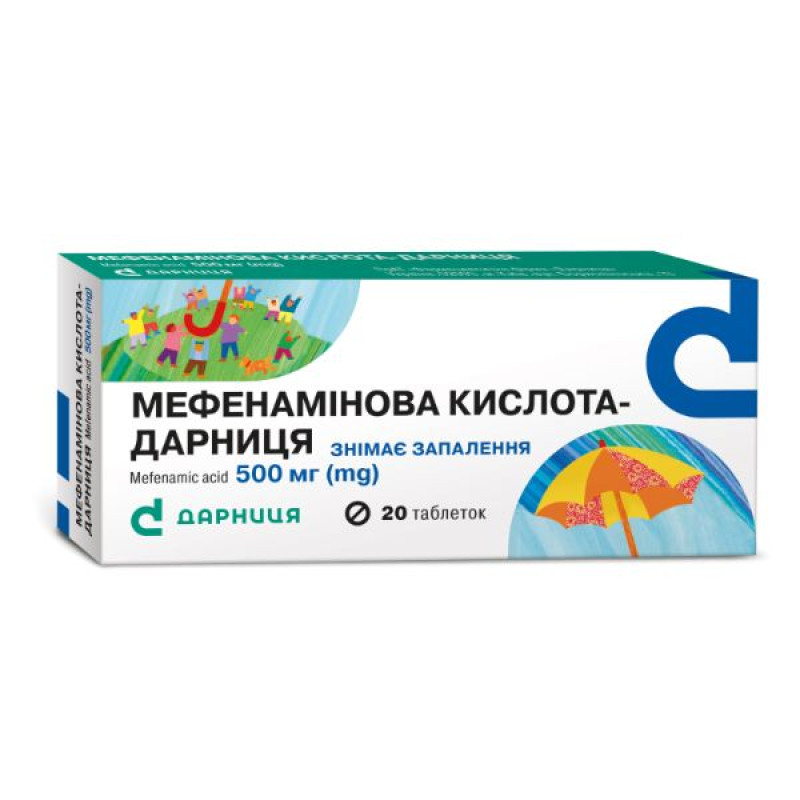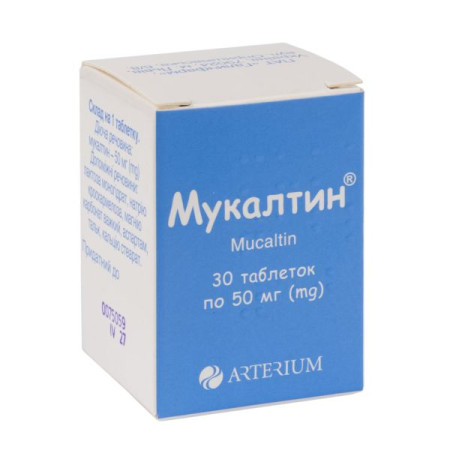Mefenamic acid-Darnitsa tablets 500 mg No. 20

Instructions for use Mefenamic acid-Darnitsa tablets 500 mg No. 20
Composition
active ingredient: mefenamic acid;
1 tablet contains 500 mg of mefenamic acid;
Excipients: potato starch, methylcellulose, croscarmellose sodium, stearic acid, magnesium stearate.
Dosage form
Pills.
Main physicochemical properties: tablets are grayish-white in color with a slightly yellowish or greenish tint, flat-cylindrical in shape, with a chamfer and a score, marbling is allowed.
Pharmacotherapeutic group
Nonsteroidal anti-inflammatory and antirheumatic drugs. Fenamates. Code ATXM01A G01.
Pharmacological properties
Pharmacodynamics
Mefenamic acid is a nonsteroidal anti-inflammatory drug. The mechanism of anti-inflammatory action is due to the ability to inhibit the synthesis of inflammatory mediators (prostaglandins, serotonin, kinins, etc.), reduce the activity of lysosomal enzymes involved in the inflammatory reaction. Mefenamic acid stabilizes protein ultrastructures and cell membranes, reduces vascular permeability, disrupts oxidative phosphorylation processes, inhibits the synthesis of mucopolysaccharides, inhibits cell proliferation in the focus of inflammation, increases cell resistance and stimulates wound healing. Antipyretic properties are associated with the ability to inhibit the synthesis of prostaglandins and affect the thermoregulation center.
Mefenamic acid stimulates the formation of interferon.
In the mechanism of analgesic action, along with the effect on the central mechanisms of pain sensitivity, a significant role is played by the local effect on the focus of inflammation and the ability to inhibit the formation of algogens (kinins, histamine, serotonin).
Pharmacokinetics
After oral administration, mefenamic acid is rapidly and fairly completely absorbed in the digestive tract. The maximum concentration in the blood is observed 2-4 hours after administration. The level in the blood is proportional to the dose. The equilibrium concentration (20 μg/ml) is determined on the 2nd day of administration (1 g 4 times a day). It is 90% bound to blood albumin. In the liver, it forms metabolites by oxidation, hydrolysis, and glucuronidation. The half-life (T1/2) is 2-4 hours. It is excreted from the body in unchanged form and in the form of metabolites mainly by the kidneys (67% of the dose), with feces (20-25%).
Indication
Acute respiratory viral infections and influenza.
Low and medium intensity pain: muscular, joint, traumatic, dental, headache of various etiologies, postoperative and postpartum pain.
Primary dysmenorrhea. Dysfunctional menorrhagia, including that caused by the presence of intrauterine contraceptives, in the absence of pelvic organ pathology.
Inflammatory diseases of the musculoskeletal system: rheumatoid arthritis, rheumatism, Bechterew's disease.
Contraindication
Hypersensitivity to the components of the drug. Bronchospasm, angioedema, rhinitis, bronchial asthma or urticaria in history, which occurred after the use of acetylsalicylic acid or other non-steroidal anti-inflammatory drugs (NSAIDs). Simultaneous use of specific COX-2 inhibitors. Gastric and duodenal ulcer, including a history, inflammatory bowel diseases, diseases of the blood-forming organs, severe heart failure, severe liver or kidney dysfunction, gastrointestinal bleeding or perforation caused by taking non-steroidal anti-inflammatory drugs.
Interaction with other medicinal products and other types of interactions
Thiamine, pyridoxine hydrochloride, barbiturates, phenothiazine derivatives, narcotic analgesics, caffeine, diphenhydramine increase the analgesic effect of the drug.
The combined use of mefenamic acid and methotrexate increases the toxic effects of methotrexate.
Antihypertensive agents (ACE inhibitors and angiotensin II receptor antagonists): reduced antihypertensive effect, increased risk of renal failure, especially in elderly patients. Patients should be adequately hydrated. Renal function should also be assessed at the start of treatment and during concomitant therapy.
Diuretics: decreased diuretic effect. Diuretics may increase the nephrotoxicity of NSAIDs.
Cardiac glycosides: NSAIDs may exacerbate heart failure, reduce glomerular filtration rate, and increase plasma levels of cardiac glycosides.
Cyclosporines: increased risk of nephrotoxicity.
Mifepristone: NSAIDs should not be taken for 8 to 12 days after taking mifepristone – NSAIDs may reduce the effect of mifepristone.
Corticosteroids: increased risk of gastrointestinal ulcers and bleeding.
Antiplatelet agents and selective serotonin reuptake inhibitors: increased risk of gastrointestinal bleeding.
Fluoroquinolones: NSAIDs increase the risk of seizures.
Aminoglycosides: NSAIDs increase the risk of nephrotoxic effects.
Tacrolimus: possible increased risk of nephrotoxic effects.
Lithium preparations: decreased lithium excretion and increased risk of lithium toxicity.
Mefenamic acid increases the activity of oral anticoagulants, so their simultaneous use increases the risk of bleeding. The simultaneous use of mefenamic acid with oral anticoagulants requires careful monitoring of prothrombin time. NSAIDs should be taken with particular caution with warfarin or heparin - medical supervision is necessary.
Concomitant use with other nonsteroidal anti-inflammatory drugs increases the anti-inflammatory effect and the likelihood of gastrointestinal side effects.
Application features
The drug is prescribed with caution to patients with acute cardiovascular failure, arterial hypertension, and ischemic heart disease.
The drug is prescribed with caution to patients with epilepsy.
Mefenamic acid should not be used in patients who have previously experienced hypersensitivity reactions, such as asthma, bronchospasm, rhinitis, angioedema, or urticaria.
Do not use in dehydrated patients who have lost fluids due to vomiting, diarrhea, or increased urination.
For long-term treatment of headaches, you should consult a doctor.
There are no special recommendations for the use of the drug in cases of moderate liver or kidney dysfunction.
NSAIDs should be used with caution in patients with a history of gastrointestinal disease (ulcerative colitis, Crohn's disease), as exacerbation of the disease is possible. If the use of mefenamic acid has led to gastrointestinal bleeding or perforation, treatment with the drug should be discontinued.
Elderly patients are generally at increased risk of gastrointestinal side effects, especially gastrointestinal bleeding and perforation, which can be fatal, so treatment should be started at the lowest dosage.
Patients with systemic lupus erythematosus and mixed connective tissue diseases are at increased risk of aseptic meningitis.
Mefenamic acid should be used with caution in patients at high risk of serious skin reactions, including exfoliative dermatitis, Stevens-Johnson syndrome, and toxic epidermal necrolysis. Mefenamic acid should be discontinued at the first appearance of skin rash, mucosal lesions, or any other sign of hypersensitivity.
With long-term use of the drug, it is necessary to monitor blood parameters, since mefenamic acid can cause pathological changes in the blood. If any dyscrasia occurs, drug therapy should be discontinued.
Taking mefenamic acid may cause gastrointestinal disorders (e.g. diarrhoea). They may occur both immediately after taking the medicine and after long-term use. If such symptoms occur, the medicine should be discontinued.
Caution should be exercised when administering mefenamic acid to patients receiving concomitant therapy with drugs that increase the risk of bleeding: corticosteroids, anticoagulants (warfarin), and aspirin.
Mefenamic acid may impair female fertility and is not recommended for women attempting to conceive. If used by women with symptoms of dysmenorrhea and menorrhagia and no therapeutic effect is observed, a doctor should be consulted.
Use during pregnancy or breastfeeding
The medicine is not used in women during pregnancy or breastfeeding.
Ability to influence reaction speed when driving vehicles or other mechanisms
Caution should be exercised when driving or operating machinery that requires increased attention, as sometimes the use of the drug can cause drowsiness, blurred vision, and seizures.
Method of administration and doses
The drug should be used under the supervision of a doctor who determines the dose and duration of treatment. It is administered orally. The drug should be taken after meals, washed down with milk.
Adults and children over 12 years of age are prescribed 250-500 mg 3-4 times a day. According to indications and with good tolerability, the daily dose is increased to the maximum - 3000 mg, after achieving a therapeutic effect, the dose is reduced to 1000 mg/day.
Children aged 5 to 12 years - 250 mg 3-4 times a day.
The course of treatment for joint diseases can last from 20 days to 2 months or more. In the treatment of pain syndrome, the course of treatment lasts up to 7 days.
Children
The drug is contraindicated in children under 5 years of age.
Overdose
Treatment. There is no specific antidote. Gastric lavage with a suspension of activated charcoal. Alkalization of urine, forced diuresis. Symptomatic therapy. Hemosorption and hemodialysis are ineffective due to the strong binding of mefenamic acid to blood proteins.
Adverse reactions
On the part of the organs of vision: visual impairment, reversible loss of the ability to distinguish colors, eye irritation.
From the side of the organs of hearing and vestibular apparatus: tinnitus, otalgia.
Respiratory, thoracic and mediastinal disorders: dyspnea, bronchospasm.
Gastrointestinal: epigastric pain, anorexia, heartburn, nausea, flatulence, vomiting, enterocolitis, colitis, exacerbation of colitis and Crohn's disease, gastritis, hepatotoxicity, steatorrhea, cholestatic jaundice, hepatitis, pancreatitis, hepatorenal syndrome, hemorrhagic gastritis, peptic ulcer with or without bleeding. Gastrointestinal bleeding, perforation or gastrointestinal bleeding, sometimes fatal, especially in elderly patients, dyspepsia, constipation, diarrhea.
Renal and urinary disorders: dysuria, cystitis. Renal dysfunction, albuminuria, hematuria, oliguria or polyuria, renal failure, including papillary necrosis, acute interstitial nephritis, nephrotic syndrome, allergic glomerulonephritis, hyponatremia, hyperkalemia.
From the nervous system: drowsiness or insomnia, weakness, irritability, agitation, headache, blurred vision, seizures, optic neuritis, paresthesia, dizziness, rigidity of the occipital muscles, fever, loss of orientation.
On the part of the psyche: confusion, depression, hallucinations.
Cardiovascular system: arterial hypertension, arrhythmia, rarely - congestive heart failure, peripheral edema, syncope, arterial hypotension, palpitations, shortness of breath, thrombotic complications (e.g. myocardial infarction or stroke).
Blood and lymphatic system disorders: aplastic anemia, autoimmune hemolytic anemia, prolonged bleeding time, eosinophilia, leukopenia, thrombocytopenia, decreased hematocrit, thrombocytopenic purpura, agranulocytosis, neutropenia, pancytopenia, bone marrow hypoplasia.
Immune system: hypersensitivity reactions, including skin rash, skin itching, facial edema, allergic rhinitis, angioedema, laryngeal edema, Stevens-Johnson syndrome, toxic epidermal necrolysis, erythema multiforme, urticaria, bullous pemphigus, photosensitivity, asthma, anaphylaxis.
Skin and subcutaneous tissue disorders: purpura, skin rash, pruritus, erythema multiforme, urticaria, bullous pemphigus.
Laboratory indicators: impaired glucose tolerance in patients with diabetes mellitus, positive reaction in some tests for the presence of mefenamic acid and its metabolites in bile and urine. Increased levels of liver enzymes in blood plasma.
Others: aseptic meningitis, sweating, fatigue, malaise, multiple organ failure, hyperthermia.
Expiration date
2 years.
Storage conditions
Store out of the reach of children in the original packaging at a temperature not exceeding 25 °C.
Packaging
10 tablets in a contour blister pack; 2 contour blister packs in a pack.
Vacation category
Without a prescription.
Producer
PrJSC "Pharmaceutical Company "Darnitsa".
Location of the manufacturer and its business address.
Ukraine, 02093, Kyiv, Boryspilska St., 13.
There are no reviews for this product.
There are no reviews for this product, be the first to leave your review.
No questions about this product, be the first and ask your question.





